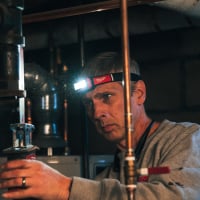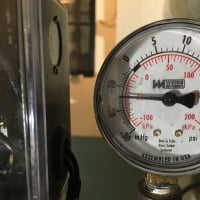Interior line set runs?
Hello Gentlemen and others,
I come looking for your thoughts regarding heat-pump installation at an 1897 Victorian that we are rehabilitating in upstate NY. The home is three stories of which only the first and second floors will be conditioned. The ceiling of the second floor is being vapor sealed and insulated above the barrier.
It is my intention to install heat pumps designed for low temperature operation. At present the plan is to use ceiling cassettes in 8 locations. Taking note of several incidents of line leaks reported here on the forum I’m getting nervous about interior line set runs. I’ve been planning to run all of the line sets up interior walls. To address possible future line set leaks I’ve been eye-balling the structure to see whether I might be able to run 3” PVC or flex duct as chases for the line sets, but it appears I could only do this for part of most runs, not the whole way to the cassette in most instances.
Alternately I can take the line sets outside and up the siding, but I really, really don’t want to do that for aesthetic reasons.
The third alternative is to switch to small diameter air ducting with it’s attendant noise and loss of efficiency. Right now I have top to bottom access with sheet rock on only one side of the interior walls, ceilings open.
Your thoughts and opinions will be much appreciated. How afraid of line set leaks should I be?
Jim
Comments
-
I used this line set because it had an extra coating, but time will tell. I recently had harder time getting the flairs on the 1/4 line just right, but that could have my ecentric flairng tool. I had no problem bending, but one review did't like the way it bent in a 7/8 line set. They say you have to caulk each end of the tubing and insulation for best practice to help avoid the corrosion.
1 -
Ceiling units— aren't there some between floors? "Future proofing" doesn't seem realistic. If they are all in the attic then yes maybe your 'pvc route' will work if it's a straight shot.
I think leaking lines is a thing of the past. Although, 18 months ago we had a gusher of a leak on a brand new line. That was an eye-opener. It was Great Lakes copper, not a European or Asian import
Also, some building inspectors may get funcky when they see chases.
If you were doing wall units: I was at a job a few weeks ago, some other co was roughing in minis, new construction. I gasped out loud when I saw all the copper whips twisted into the stud bays. Flare joints inside the 2x4 wall, gross me out. When we do new construction, we are bending the copper lines into the "left" side of the unit. And we are setting up the drain whips, so we want the wall unit(s) on side so we can land the drain whips exactly.
Gary
1 -
-
We never had any issues with the white linesets, FWIW.
Get it in the walls, solder the ends shut, run them up to 600 lbs, & leave them like that until the walls are trimmed. I had to repair a ⅜ liquid line in the wall of a condo once, where the guy shooting the baseboard up was using 6" long nails. At lease, they were waaaay longer than needed.
1 -
I was told at a class for the new A2L refrigerants that running linesets up interior walls should be avoided at all costs, if you do it you should run it through a PVC conduit. I wouldn't want a hidden flare connection no matter what refrigerant is being used.
Ceiling cassette units in a residential building with Sheetrock ceilings sounds like a recipe for a service nightmare in my opinion. My brother wanted to do this in the house he's building, I'm glad I was able to talk him out of it. I'd rather go with a Unico/Space Pack high velocity system if you can't install a proper ducted system.
2 -
-
This is one of the reasons why installing a heat pump system in an older building is a nightmare. There are others — not the least of which is that it will rarely heat as well in tetms of comfort as what was there.
Which, I assume, has all be ripped out… sadly.
That said, It is rare to not be able to run the pipes and control wiring and drainage tubing up the outside of the building in inexpensive, but not ugly, well designed chases, and then use through the wall or wall mount cassettes inside, and this is what I would recommend.
Br. Jamie, osb
Building superintendent/caretaker, 7200 sq. ft. historic house museum with dependencies in New England1 -
-
-
This!
8 ceiling cassettes is a bad idea for many many reasons. It will never run well, be noisy and a maintaince nightmare. Your line set worry will be the least of your problems. You want to find a different HVAC person.
If you want proper operation, a fully ducted setup is the only way to go. This is harder in old houses but not impossible.
Sometimes you can compromise a bit say a wall mount or two in larger spaces but small rooms like bedrooms need to be ducted.
The budget solution is a wall mount on every level with resistance baseboard in rooms to even out the temperature.
1 -
@kaos they do work, you know! "never run well"? Isn't that a little extreme?
1 -
-
I had longtime, ongoing issues with one zone of my central AC. I'm not an AC guy, but after having 6 or 7 AC "pros" misdiagnose & charge me big bucks, I punched the linesets out of the attic wall & ran it down to the unit in this nice, track system. I too have an old Victorian, but I'm very happy with the way this looks. Mad Dog
1 -
Many definition of works, they do after all produce cooling and heat. That doesn't mean there are not issues with them.
Look at post #14 here:
First issue is all these small heads on a large multi split will only ever be able to run at full power and off. Combine with the fact that they are oversized by a factor of 3x for most bedrooms, comfort and humidity control is terrible. Since they cycle, you hear the refrigerant flow and expansion noise with each cycle. Reversing flow for defrost is also never quiet plus most ceiling units run a condensate pump. Add these together and there is a good chance the unit will wake you up in the middle of the night. Mine does.
The many small units on a big outdoor unit generally means there is refrigerant bypass through zones that are off. This can create overheating in off zones and is terrible for efficiency as that unused refrigerant is just sent back out. There is a light commercial place with a couple of large multi splits that measure the COP of the setup, ended up around 1.5 or so. That is well bellow nameplate COP so operating cost is about 2x of a regular ducted unit. That is not a small cost delta.
On an 8 zone you also now have 32 flare connections plus 4 more for the branch box. Based on the quality of install I see locally, chances of all those being leak free is pretty low. Even if they don't have detectable leaks, all flare connections loose a tiny bit of refrigerant over time so there is a good chance of needing top up.
I would really love for ceiling/wall mount mini splits per room would work but there are just too many things against it.
Mine is coming out and getting replaced with a ducted heat pump.
1 -
why would properly made flare connections leak? there are lots of systems 80+ years old with flare connections that have managed to hold on to their charge.
not being able to match the modulating compressor to the load was a design decision by the manufacturer, it isn't an inherent problem but probably exists with what is available on the market.
the condensate pumps built in to dehumidifiers are awful, i don't know if the ones in mini splits are any better.
1 -
Properly assembled*, they don't leak a lot but not zero.
https://docs.lib.purdue.edu/cgi/viewcontent.cgi?article=2939&context=iracc
As for matching, compressors can only turn down so much. You have a big compressor, it will never be able to turn down to a fraction of ton output needed for running a single small zone. All multi splits also need to send some refrigerant through all the zones in heat mode regardless if the zone is running, now way to design around that.
Multi split with a couple of large zones does actually work reasonably well. Still not as well a one compressor to one indoor unit pairing.
*This is much harder than it should be in real life.
1 -
I don't know if there is any limit to the pump that would prevent it from reducing its output to something like 1% of its full output if you slow it down sufficiently. I don't see why there would be but i might be missing something. even if there is you could use a large and a small compressor to cover the range. you can always use variable displacement or bypass like they do on automotive compressors.
1 -
Personally i would not do 8 cassettes. But then again I probably wouldn't do a heat pump.
To me cassettes are going to be a lot of maintenance. Then if one goes bad and a few years down the road the MFg has changed the design and (they will). the new one doesn't fit now that is a problem. We are not in an office with a drop in ceiling.
I have never seen a customer happy with overhead heat especially in that type of building and especially with a HP. You need some fan speed to distribute the heat and the low temp air from a HP will feel cold with any velocity to it. On cooling it will work great. And the condensate pumps in cassettes are a problem.
Not to mention if you develop a leak it is a nightmare to find.
2 -
-
Thank you to everyone who responded to my question. I've decided that changing to a ducted system will be best for the long term viability of the house. An air handler in the basement may be able to use some of the original gravity powered heat ducting to supply both floors. An air handler in the attic can supply the second floor. I did save the original gravity "octopus" furnace, resealing the firebox. I'm keeping that as a "functional antique". Again, Thank you!!
2
Categories
- All Categories
- 87.3K THE MAIN WALL
- 3.2K A-C, Heat Pumps & Refrigeration
- 61 Biomass
- 427 Carbon Monoxide Awareness
- 119 Chimneys & Flues
- 2.1K Domestic Hot Water
- 5.8K Gas Heating
- 114 Geothermal
- 165 Indoor-Air Quality
- 3.7K Oil Heating
- 76 Pipe Deterioration
- 1K Plumbing
- 6.5K Radiant Heating
- 395 Solar
- 15.6K Strictly Steam
- 3.4K Thermostats and Controls
- 56 Water Quality
- 51 Industry Classes
- 50 Job Opportunities
- 18 Recall Announcements






